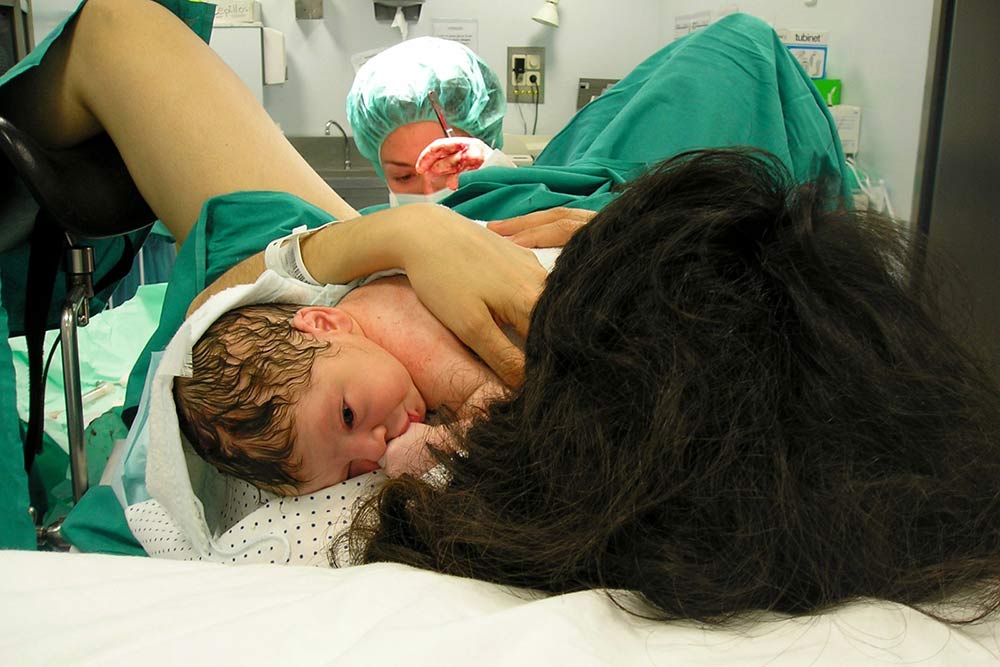5 Common Fears About Giving Birth—and How to Cope

It’s natural to worry about giving birth, but take heart—*not* knowing what to expect is much worse than what you can expect.
Expert Sources: Lauren Streicher, MD; Kate Stroud, CD
Your baby’s delivery day is coming, and no matter how much you’re looking forward to meeting your bundle, you can’t help but think—or panic a little—about the birth process. It’s understandable, with all the traumatic birth stories you hear from well-meaning family and friends looking out for you and your baby, but don’t let stress get the best of you.
With the help of experts and veteran moms, we’ve compiled some of the top labor concerns to help you prepare (and hopefully put your mind at ease), so you can feel more confident walking into the big day.
I Won’t Be Able to Differentiate Between Real and False Labor
Toward the end of your third trimester, you might get contractions that don’t lead to labor. Also called Braxton Hicks contractions or false labor, these low-level, irregular contractions are helping prep your body for the real deal (think of them as a dress rehearsal), but they can easily trick you into thinking it’s go-time, especially for a first-timer
If you’re having contractions—tense, cramping sensations—try changing positions. Lie on your side, and see if they go away. If the contractions don’t demand your full attention, try distracting yourself with a movie, go for a walk, or even scroll through TikTok—whatever it takes to help keep your mind off the situation.
When your contractions become more frequent and intense, don’t think twice, it’s time to give your OB-GYN a call or head to the hospital or birth center. If you end up being sent home, don’t worry, it’s no big deal, the medical staff is used to false alarms in labor and delivery.
Imagining What Labor Pains Will Feel Like Keeps Me Up at Night
Enduring countless labor horror stories from other moms is par for the pregnancy course. And unfortunately, those who had a positive birth usually aren’t the most vocal. It’s no wonder anxiety about your first birth can skyrocket by the time your due date arrives. Will contractions hurt? Yes, but how much depends on the stage of labor, your pain tolerance, your body and your baby’s body, and even how scared you are.
“Fear of giving birth creates tension, and tension increases pain,” warns Kate Stroud, a birth doula in Ypsilanti, Michigan. “If you’re fearful, you can also slow your labor down.” Instead of obsessing over potential discomfort, learn pain relief techniques to help you cope, like meditation and breathing methods.
Additionally, it can help to read up on different pain management medications available to you during delivery, such as an epidural. You don’t have to commit to a decision on whether you want pain medication yet—you can see how early labor goes and make the final call on any interventions when the time comes.
I’ll Be Mortified if I Poop on the Delivery Table
Of course, no one wants their birthing partner (or anyone, really) to witness this scene, but if it happens, it is a perfectly normal part of childbirth. After all, you’re using the same muscles to push a baby out as you do to have a bowel movement.
And, if you’re worried about how the medical team will react, think about how often bodily functions come up in health care. These professionals have seen it all and are not grossed out.
Whatever you do, don’t let your phobia force you to hold back while pushing. “My fear of pooping on the delivery table almost changed the course of my delivery,” says Melanie Hoagland, mom in Shawnee, Kansas. “I was trying so hard to push, yet not do it too hard. After more than two hours, I was told I had two more pushes, and then we were going to have to move to a C-section. You can bet I pushed [harder than ever]—and got the baby out in two pushes! Avoiding embarrassment was not worth getting a cesarean if I didn’t have to.”

I Know I’ll Be Devastated if My Birth Plan Isn’t Followed
Creating a birth plan can be an important step in helping you feel more in control of your labor and delivery experience and getting you, your birth partner, and your health care provider in agreement before the birth actually takes place.
Instead of handing the birth plan over to your nurse, use it to start a conversation, advises Stroud. It’s a great way to get everyone feeling like they are on the same team, and it might also prompt your nurse to share the hospital’s standard of care protocols with you, particularly procedures like delayed cord clamping, immediate skin-to-skin contact, and breastfeeding.
I’m Afraid of Tearing or Getting an Episiotomy
This one fills a lot of parents-to-be with dread—and makes us want to cover our crotches in angst. But in reality, it’s not as bad as it sounds. An episiotomy (an incision made around the vaginal opening to widen it) is no longer a routine procedure. It’s typically only used now in special circumstances, like when a baby needs to be delivered quickly or is in an abnormal position. (Note: No matter the circumstance, your doctor should always inform you of an episiotomy beforehand and explain the potential risks.)
Tears, however, affect around 80% of birthing parents. But keep in mind there are different degrees of tears (first through fourth), which means pain and recovery vary based on severity.
“A number of things determine if a woman will tear, such as the size of the baby, her vaginal capacity, and the amount of control during the time of delivery,” says Lauren Streicher, MD, associate professor of clinical obstetrics and gynecology at Northwestern University Feinberg School of Medicine in Chicago.
For example, Dr. Streicher explains one strategy OBs routinely use involves allowing the baby’s head to remain in the crowning position for a bit in order to fully stretch the vaginal opening rather than quickly pushing the baby out and potentially tearing the surrounding tissue. “Sometimes having an epidural makes it easier for you to control your urge to push and follow your doctor’s direction, reducing the chance of tearing,” notes Dr. Streicher.
Another preventative measure entails pushing in an upright position, like kneeling in bed or on all fours. Stroud says these positions use gravity to the birthing parent’s advantage, helping the pelvic joints open up and making it easier for the baby to pass.
Even if you do end up with a tear, you probably won’t feel it happening in the moment. Dr. Streicher explains that the pressure of your child’s head on your nerves down there numbs the area. After delivery, your care provider will quickly stitch up any tears as needed. (Before you wince at the thought, know that if you haven’t already had an epidural, your doctor will administer a local anesthetic to ensure the process is painless.)
Labor is a big deal, and rightfully so—you’re bringing a new person into the world! Having an appreciation for the miraculous work your body does intuitively (and setting your sights on future cuddle sessions) can help ease anxieties. Says Stroud, “I try to help women work through the fear of letting go—realizing this is something so much bigger than themselves.” If you just can’t get rid of the jitters, that’s OK, try to remember to trust your body to get you through. “Just like your body knows how to grow this baby, your body also knows how to birth the baby,” Stroud assures, “It inherently knows how to do labor.”







